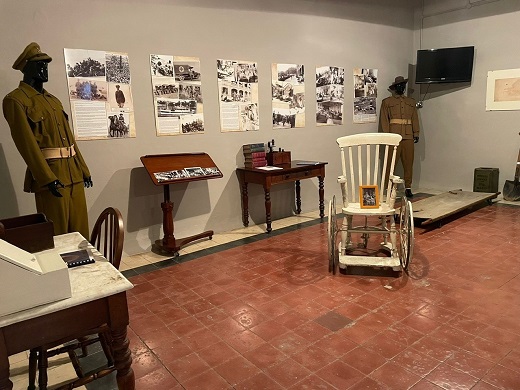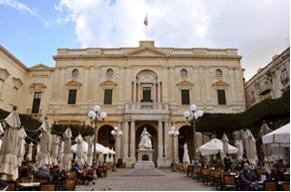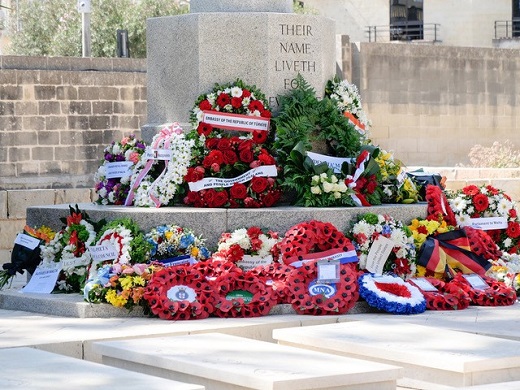Anzac Day
Anzac Day Commemorative Service
Anzac Day has been commemorated in Malta since 1916. Originally, two services were held due to the practice of burying servicemen according to religion: one service was held in Pietà and another at the Addolorata cemetery for Catholics.
After the unveiling of the War Memorial in Floriana by HM The Queen in 1954, services were combined up until 1979 when the service returned to Pietà Military Cemetery, as it contains the highest number of Anzac war graves in Malta with more than 230 burials of New Zealand and Australian casualties.

An Anzac Day Ceremony at Valletta. Lord Methuen, the Governor of Malta 1915 - 1919, is marked by a cross in the left foreground and the Roman Catholic Bishop of Malta is in the background marked with a cross. Photo Credit: Australian War Memorial
An Anzac Day Commemorative Service & Wreath Laying Ceremony is held annually on the 25th of April at the Pietà Military Cemetery. This service is dedicated to all those Australians and New Zealanders who lost their lives at Gallipoli in 1915, and in all subsequent military and peacekeeping operations, including those that are currently still active. It is also an occasion to acknowledge the role of Malta in the care of the sick and wounded, as well as the sacrifice and service of so many others in times of conflict.
The service is open to the public. Members of the public who wish to lay a wreath are welcome to do so, once invited by the Master of Ceremonies. Military medals may be worn.
The cemetery is located in Triq Id-Duluri (entrance at the junction of Triq Id-Duluri and Triq Santa Monika) Pietà.
Visitors to the service are requested to check the High Commisison's social media or the 'Events' tab on the High Commission's webpage for details on start times as these may vary from year to year.
You may access the Anza Day Commemorative Wreath Laying Order of Service from previous years by clicking on the below thumbnails.
2025
2024
The Gallipoli Connection
Malta played a significant role in and during the Gallipoli Campaign with many Australians and New Zealand casualties being evacuated to Malta for medical treatment. From the spring of 1915, hospitals and convalescent camps were established on the islands of Malta and Gozo, to deal with the many thousands of sick and wounded from the Gallipoli and Salonika campaigns. Despite the courageous efforts of the doctors and medical staff, some of the casualties could not be saved and they were buried on Malta. Of those buried on Malta there were 204 Australian and 72 New Zealanders.
The Commonwealth war burials in Malta are unlike those found anywhere else. Many joint and collective burials were made as graves had to be cut into the rock underlying the island's shallow earth crust. These graves are usually marked by flat tablets that could take several inscriptions and, for the sake of uniformity; the same type of marker was used for single graves.
Events and Places to Visit
The 'ANZAC Experience in Malta' Self Guided Tours
The 'ANZAC Experience in Malta' is a series of four individual self-guided tours to the principal sites associated with ANZAC personnel; mainly during the First World War. The tours detail where wounded ANZACs convalesced, were entertained and hospitalised, and the various final resting places of those service personnel who lost their lives. Also detailed are various other points of interest; places where both recovering and off duty service personnel may have visited.
The tours differ in length with certain tours requiring a vehicle. The tours vary in how they can be followed: either circularly – ending where they began; or in a linear fashion. A map for each specific tour is provided within the guide.
The tours can be downloaded in PDF format by clicking on the below thumbnails.
Tour 1: Arrival
Tour 2: Healing
Tour 3: Recovery
Tour 4: Departure
Commonwealth War Graves Commission (CWGC) Cemeteries and Memorials
All of the cemeteries listed below contain graves from both world wars:
The Malta (Capuccini) Naval Cemetery;
By clicking on the name of the cemetery, it will link you to the Commonwealth War Graves Commission's information page that will provide you with more information about the cemetery and location.
FREE GUIDED TOURS:
CWGC offer free guided tours at:
Imtarfa Military Cemetery every Monday, Tuesday and Friday mornings between 09:00am and 12:00pm.
Malta (Capuccini) Naval Cemetery every Tuesday and Wednesday morning between 09:30am and 12:00pm.
Pembroke Military Cemetery and Pietà Military Cemetery by appointment.
To arrange a tour, contact the Commonwealth War Graves Commission on [email protected].
Hospitals and Convalescent Camps
To cater for the over 135,000 sick and wounded from the Gallipoli and Salonika campaigns there were numerous hospitals and convalescent camps throughout Malta and Gozo.
Cottonera Military Hospital
The Cottonera Military Hospital is now St Edward’s College in Birgu which during the First World War was one of the major casualty receiving stations for many wounded ANZACs. The building was designed and constructed according to specifications recommended by Florence Nightingale to the Royal Commission's subcommittee report 'The Barrack and Hospital Improvements Commission on the Sanitary Conditions and Improvements of the Mediterranean Station' which was submitted to the UK parliament in 1863 as part of post Crimean War reforms.
St Edward’s College has a permanent display of the college's history in a dedicated exhibition room. Members of the public are welcome to visit the exhibition room without charge by contacting [email protected] with reasonable advance notice.
A list of ANZACs who passed away at Cottonera Military Hospital is available in the college's exhibition room.

St Edward’s College is located in Triq Dan Dwardu, Birgu (Citta Vittoriosa) Cottonera.
Station Hospital
The Station Hospital which is now the Mediterranean Conference Centre located at Mediterranean St, Il-Belt Valletta. Tours are conducted through this Centre by the Malta Experience.
Lazzaretto Hospital
Lazzaretto Hospital on Manoel Island can still be viewed from any of the tour boats conducting the harbour cruises from Sliema.
Bavière Hospital
The Bavière Hospital was situated in the Auberge de Bavière. The Auberge de Bavière has an ancient and honourable history, having been the headquarters of the Anglo-Bavarian Knights of St. John located at San Bastjan, Valletta. It now houses the main offices of the GPD, including the Director General's Office, the Finance & Administration Directorate, The Estate Management Directorate, the Land Directorate and the Joint Office Directorate.
St. Elmo Hospital
The St. Elmo Hospital was previously a government school that was converted in to a hospital. St. Elmo specialised as a surgical hospital. The hospital was located at Fort St. Elmo at the north end of the Grand Harbour. It was well ventilated and overlooked the breakwater.
Fort Chambray Hospital Gozo
The Fort Chambray Hospital served as an excellent Convalescent Depot (camp) during the First World War, relieving the crowded camps on Malta.
Mtarfa Hospital
The hospital was commissioned in 1912. It was used during World War I to hold many of injured Australian and New Zealand troops from the Gallipoli landings. It was expanded enormously during the Second World War.
In the 1950s it was renamed the David Bruce Royal Naval Hospital after the doctor who discovered the root cause of Malta fever, or Brucellosis. It has since been converted to a state secondary school, named after Sir Temi Zammit, part of St Nicholas College.
Ghajn Tuffieha Camp Hospital
Ghajn Tuffieha is situated 10 miles directly west of Valletta in a charming valley near the sea with hills on either side. Ghajn Tuffieha had already been used as a camp in peace time, partly by the army and partly by the navy, being in great request as a summer holiday resort both by officers and men. There is abundant room for exercise and games of every description; the bathing facilities are unrivalled, and the summer heat is greatly tempered by a cool breeze; in fact Ghajn Tuffieha was eminently suitable for making men, softened by wounds or sickness, hard and fit for service. The area is still a very popular area for tourists; there are numerous walking tracks, and swimming and other water sports may be enjoyed from the sandy beaches in Golden Bay.
Australia Hall
The area around Pembroke had a number of convalescent camps such as All Saints, St Paul's, and Spinola Camp. Australia Hall was built after the sum of £2,000 (pounds) was raised through donations by the Australian Branch of the Red Cross, at the time, to provide a place of amusement and social activities. Australia Hall was used for shows for the Forces between the wars and also during the Second World War.
Other Events/Displays and Locations:
Heritage Malta
Heritage Malta is the national agency for museums, conservation practice and cultural heritage. Heritage Malta is committed to bring culture closer to the people. The Head Office of Heritage Malta is located in the Ex-Royal Naval Hospital which is located at Triq Marina, Kalkara.
The National War Museum which is managed by Heritage Malta has a collection on display which focuses on the two World Wars (1914-18 and 1939-45). The National War Museum is located in the building known as the Old Drill Hall of Lower Fort St Elmo, Valletta.
Maritime History
Malta is renown for its maritime history and had its first encounter with an Australian war ship when HMVS Cerberus, under the command of Lieutenant William Panter, visited Malta on its maiden voyage to Australia.
An annual seminar will be hosted by the Maritime Museum with the support of Heritage Malta and Friends of the Maritime Museum titled: 'Episodes from the Great War’.
Further details regarding the seminar and the museum may be found on the following link Malta Maritime Museum,
The Malta Aviation Museum
The Malta Aviation Museum is established in three hangars in the former RAF Ta’Qali Aerodrome. The Malta Aviation Museum Foundation is a voluntary, non-profit organisation with the objective to create a display of unique exhibits related to Malta’s rich aviation history. The Museum has a display showing the unique involvement of the RAAF’s involvement in Malta’s aviation history.
The National Library
The National Library of Malta is the national repository of information, holding precious historical archives and collections as well as architecturally being a cultural asset. The National Library holds a number of significant collections, such as a small but interesting collection of sixty incunabula, the Melitensia collection comprising of published material in the form of books, pamphlets, newspapers, journals and single sheet items, as well as audio and visual recordings by Maltese authors, or on any subject related to the Maltese Islands. The National Library also conserves the Archives of the Order of Malta with the earliest document dating back to 1107.
Find out what else is happening at the National Library via their Facebook page.
The Malta National Library is located at 36 Old Treasury Street Valletta.

St Andrew's Scots Church
St Andrew’s Scots Church in Valletta has two stained glass windows representing Christ the Light and Christ the Good Shepherd. These windows were dedicated at the Methodist Church in Floriana in 1921. There were a gift of Australian and New Zealand Methodists as a memorial to their compatriots who died of the wounds they suffered in the Gallipoli campaign and lie buried in Malta. In 1974, the Methodist Church in Floriana closed down and the windows were taken to St Andrew’s as part of the restoration scheme for the church.
The Malta Memorial
The Malta Memorial is a commemorative war memorial monument in the vicinity of Floriana. It is dedicated to those men and women of the Commonwealth Air Forces who lost their lives in the various Second World War air battles and engagements around the Mediterranean and who have no known grave. More than 2,300 airmen, including 211 members of the Royal Australian Air Force, died in raids and sorties over and around Malta. The Memorial consists of a column, 50 feet high, surmounted by a bronze gilded eagle around eight feet in height, and is set on a circular base on which the names are inscribed on a bronze panel.
The inscription at the bottom of the bronze panel in memoriam of these men and women reads as follows:
“OVER THESE AND NEIGHBOURING LANDS AND SEAS THE AIRMEN WHOSE NAMES ARE RECORDED HERE FELL IN RAID OR SORTIE AND HAVE NO KNOWN GRAVE MALTA GIBRALTAR MEDITERRANEAN ADRIATIC TUNISIA SICILY ITALY YUGOSLAVIA AUSTRIA PROPOSITI INSULA TENAX TENACES VIROS COMMEMORAT”
Re-enactment of the Awarding of the George Cross to Malta
‘To honour the brave people I award the George Cross to the Island Fortress of Malta to bear witness to a heroism and devotion that will long be famous in history'.
This proclamation was issued by King George VI, on 15 April, 1942, to honour the people of Malta. The honour bestowed was a sign of appreciation by the British Monarchy for the bravery and tenacity that was being shown by the Maltese people during the darkest moments of World War II.
The actual George Cross medal was brought over to Malta by Lord Viscount Gort, VC., who had just been appointed and sent to Malta as Governor and Commander-In-Chief. It was presented to the people of Malta during a ceremony that was held on 13 September in St George's Square, Valletta. Chief Justice Sir George Borg received the medal on behalf of the Maltese nation.
Each year on April 15 the day of the anniversary of the Maltese George Cross, the Malta Tourism Authority presents a commemorative celebration recalling the historic event.
A ceremonial re-enactment is held in St George’s Square, Valletta reviving this landmark episode in Maltese history. The re-enactment includes the participation of the Armed Forces of Malta, the Malta Police Force and their musical bands, together with several talented actors from the In Guardia Unit of the MTA, Malta Command WW2 Living History Group all dressed as they were in 1942.
For more information on this and other events the Malta Tourism Authority web site http://www.mta.com.mt/
Anzac Portal
The Department of Veteran Affairs has launched a website, called the Anzac Portal, which provides information and rescources about the Anzac Centenary, the First World War, and all conflicts that Australians have served in from the Boer War to the present day.
The portal provides educational, historical and events information to support a greater understanding and awareness of the Anzac Centenary and includes:
- Classroom ready learning activities
- Australian wartime history publications and websites
- Veterans' interviews
- Anzac Day and Remembrance Day posters
- An interactive Victoria Cross map
- Links to a range of government, cultural institutions and veteran Anzac centenary commemorative programs
The Anzac portal can be accessed on: www.anzacportal.dva.gov.au/

